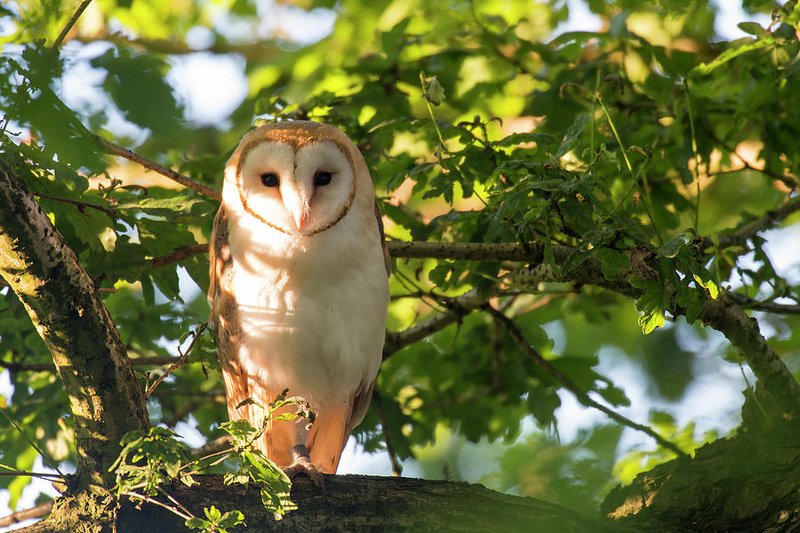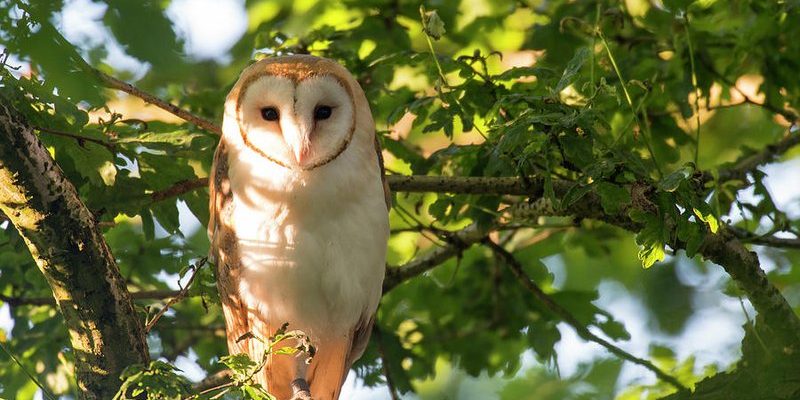
The Barn Owl is one of nature’s most fascinating creatures, known for its heart-shaped face and ghostly appearance. Imagine walking through a quiet field at dusk and suddenly catching sight of a pale silhouette gliding silently above the grass. That’s the Barn Owl, a bird that captures both the imagination and curiosity of many. With their wide wings and keen senses, these nocturnal birds have become symbols of mystery and wisdom.
What makes the Barn Owl truly special? Well, aside from their striking looks, they boast incredible hunting skills and play a vital role in our ecosystems. Whether you’re a birdwatching enthusiast or just curious about wildlife, understanding the Barn Owl can deepen your appreciation for the natural world around you.
Physical Characteristics
Barn Owls are instantly recognizable due to their unique features. They have a distinctive heart-shaped face, a trait that not only adds to their beauty but also helps them hear better by directing sound to their ears. Their plumage varies in color, ranging from a soft cream to light brown with speckled patterns, allowing them to blend in with their surroundings during the day. This camouflage is crucial for avoiding predators, especially when they roost in trees or buildings.
In terms of size, Barn Owls typically measure between 12 to 24 inches in length, with wingspans reaching up to 43 inches. These long wings enable them to fly silently, making them stealthy hunters of the night. They also have long, slender legs with powerful talons that help them catch their prey—usually small mammals like mice and voles. The combination of size, shape, and coloration gives the Barn Owl a magnificent presence, especially when seen in flight.
Habitat and Distribution
Barn Owls have a wide distribution, inhabiting regions across the globe except in extreme polar areas and some remote islands. They thrive in open habitats such as farmland, grasslands, and floodplains, often nesting in old barns or tree cavities. This preference for abandoned structures not only provides shelter but also a prime hunting ground where they can easily spot and catch small rodents.
Interestingly, the Barn Owl’s adaptability to various environments makes it a resilient species. In urban areas, they’ve found success by nesting in warehouses and silos. Their ability to thrive in such diverse habitats speaks volumes about their adaptability and resourcefulness. However, they do require specific conditions, such as a steady food supply and suitable nesting sites, to maintain healthy populations.
Behavior and Hunting Techniques
What truly sets the Barn Owl apart is their method of hunting. These birds are primarily nocturnal, using their exceptional night vision and acute hearing to detect prey even in complete darkness. They can locate a mouse rustling in the grass by pinpointing the sound of its movements—a characteristic that is less common in many other birds of prey. Hunting in silence is key to their success, and their specialized feathers help to reduce noise while flying.
The hunting process of a Barn Owl is intriguing. They typically hunt alone and will glide above their territory, scanning the ground for movement. Once they spot potential prey, they swoop down gracefully, catching their target with their sharp talons. This technique not only highlights their remarkable hunting skills but also their reliance on stealth and patience.
Diet and Feeding Habits
As carnivores, Barn Owls primarily feast on small mammals, with a particular fondness for rodents. In fact, studies show that they can consume up to 1,000 mice per year! This makes them incredibly valuable in controlling rodent populations, which is essential for farmers and ecosystems alike. Aside from rodents, they may also eat birds, insects, and occasionally reptiles, depending on what’s available in their environment.
The way Barn Owls consume their food is quite unique as well. They often swallow their prey whole, digesting the softer tissues while later regurgitating the indigestible parts, like fur and bones, as pellets. Observing these pellets can actually provide insights into their diet and the local ecosystem, giving researchers a glimpse into the types of animals present in the area.
Reproduction and Lifespan
When it comes to reproduction, Barn Owls are monogamous, often forming strong pair bonds that last several breeding seasons. The breeding season typically occurs in the spring, when male Barn Owls will perform elaborate courtship flights to attract a mate. Once paired, they seek out a suitable nesting site, often in old buildings or tree hollows, where the female will lay a clutch of about 3 to 7 eggs.
The incubation period lasts around 30 days, and after hatching, the chicks require intensive care from both parents. They grow quickly and are usually ready to leave the nest within 8 to 10 weeks. In the wild, Barn Owls can live up to 4 years on average, but some have been known to reach ages of 15 years or more in captivity. Their lifespan is heavily influenced by environmental factors and the availability of food.
Conservation Status
While the Barn Owl is still found across many regions, their populations have been declining due to habitat loss, agricultural practices, and rodent control measures. The use of pesticides can have a detrimental impact on their food sources, further contributing to their decline. Conservation efforts are focused on preserving their habitats by encouraging responsible farming practices and creating nest boxes to provide safe nesting sites.
Awareness and education about the importance of Barn Owls in ecosystems can also play a significant role in their conservation. By understanding their role as natural pest controllers, communities can foster a relationship that promotes coexistence rather than conflict.
Interesting Facts
| Scientific Name: | Tyto alba |
| Wingspan: | Up to 43 inches |
| Diet: | Rodents, insects, small birds |
| Average Lifespan: | 4 years in the wild; up to 15 years in captivity |
| Nesting Preference: | Old barns, tree cavities |
The Barn Owl is much more than just a beautiful bird with a haunting presence. They are remarkable hunters, essential components of many ecosystems, and symbols of nature’s mysterious ways. Understanding their behavior, habitat, and ecological importance can inspire us to appreciate these creatures and take steps to protect them. So next time you’re out in the fields or forests at dusk, keep an eye out for the stunning Barn Owl soaring through the night sky. You might just witness a true marvel of nature!
FAQ
What do Barn Owls sound like?
Barn Owls are known for their unique vocalizations, which include a series of high-pitched screeches, hisses, and clicks. Their calls, often described as eerie or ghostly, can be heard at night and are typically used to communicate with their mate or establish territory. Unlike other owls that hoot, the Barn Owl’s sound can be startling, especially in the stillness of the night.
Are Barn Owls dangerous to pets?
While Barn Owls are skilled hunters, they primarily prey on small rodents and birds, which means they are not a direct threat to household pets like cats or dogs. However, very small pets like rabbits or guinea pigs may be at risk if left outside at night. Barn Owls serve a vital role in controlling pest populations, benefiting gardens and farms alike.
Can I attract Barn Owls to my property?
Yes! If you want to attract Barn Owls, you can install a nesting box in your yard. Choose a quiet location that mimics their natural nesting sites, like an old barn or tree. Ensuring a nearby habitat with ample food sources, like fields or meadows, will increase the chances of them taking up residence. It’s a win-win situation for you and the owls!
Do Barn Owls migrate?
Barn Owls are generally not considered migratory birds. Instead, they tend to stay within their home range throughout the year, although they may disperse to find new territory or food sources if conditions become unfavorable. Some individuals may move short distances depending on seasonal factors, but many remain in the same area all year long.
How can I help Barn Owls?
You can help Barn Owls by supporting habitat conservation efforts and advocating for sustainable farming practices. Creating awareness about their ecological importance can also contribute to their protection. Additionally, installing owl boxes and reducing pesticide use can promote healthy Barn Owl populations, benefitting the environment as a whole.
What is the difference between a Barn Owl and a typical owl?
Barn Owls differ from many other owls in several ways, including their physical characteristics and hunting style. Unlike typical owls that often have round faces and hoot, Barn Owls have heart-shaped faces and produce screeches. Their hunting method also involves silent flight and acute hearing to find prey, setting them apart as unique nocturnal hunters.
Are Barn Owls social birds?
Barn Owls are generally solitary outside of the breeding season. They typically hunt alone and maintain their own territories. However, they may roost in groups under certain conditions. During the breeding season, pairs become more social, working together to care for their young. The bond between mating pairs can be strong, showcasing a level of social interaction for breeding.
How do Barn Owls find their prey?
Barn Owls use a combination of their excellent night vision and acute hearing to locate prey. They can detect sounds made by small animals in the grass and pinpoint their location. Their silent flight, aided by specialized feathers, allows them to approach their target without being noticed, making them highly effective hunters during the night.
What do Barn Owl chicks look like?
Barn Owl chicks are initially covered in white down feathers, making them look quite fluffy and cute. As they grow, they develop their adult feathers, which take on the characteristic coloration of Barn Owls. The chicks are dependent on their parents for food and care for several weeks before fledging, and during this time, they exhibit endearing behaviors that showcase their development.
Why are Barn Owls considered beneficial?
Barn Owls are considered beneficial because they help control rodent populations, which can be particularly damaging to crops and gardens. By naturally keeping these populations in check, they reduce the need for chemical pest control methods that can harm the environment. Their role in maintaining ecological balance highlights their importance within ecosystems where they are found.
Can I see Barn Owls during the day?
While Barn Owls are primarily nocturnal, they can sometimes be seen during the day, especially in overcast weather or if they are disturbed from their roost. However, it’s quite rare, as they prefer to hunt and be active at night. If you’re curious about spotting one, your best chance is to venture out in the early morning or late evening when they are most active.

